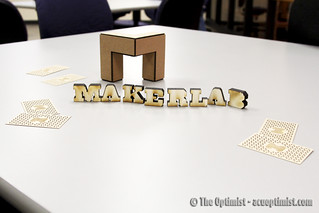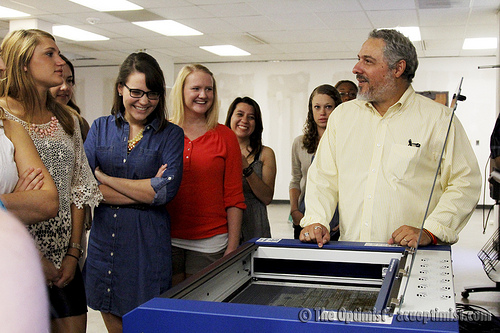ACU’s Mobile Learning Initiative and the AT&T Learning Studio put the school on the map as a technology trailblazer in higher education.
And with the university’s newest development, the “innovative and real” mantra never held more true.
During this year’s homecoming events, the Library will open its Maker Lab, providing creative tools and a workspace that encourages “Maker” technology by helping bridge the digital and physical world.
Towards the end of the Fall 2012 semester, the idea to create a campus makerspace came from Dr. John Weaver, Dean of Libraries and Educational Technology.
But ACU’s Makerspace is part of bigger picture off-campus.
The Makerspace concept is a growing movement nationally, the idea of creating a space that a community can share resources and knowledge to build and make things.
Crafting this novel concept of makerspace, the Library’s new makerspace will put ACU ahead of the game, Weaver said.
“Though the Maker Movement and Makerspaces have been around for a few years, the ACU Library will be among the first academic libraries to host a Makerspace,” he said.
Having visited a number of Makerspaces in large urban areas, such as Chicago, New York City, Dallas, and Austin, Weaver said no two spaces are alike, each mimicking the changing and evolving needs of the community, remaking themselves across time.
Research and exploring the Maker Movement commenced the following spring, leading to the documenting of the interviews in a film called “We Are Makers”.
The film came from conversation about the potential impact the Maker Movement could have in the educational environment and reviving the human element and creating of technology.
Produced by Kyle Dickson, AT&T Learning Studio director and English professor, Matthew Bardwell and Nathan Driskell, AT&T Learning Studio media production specialists and James Langford, director of educational technology, the video ignited with over 13,000 Vimeo views.
“We set out to not just get a bunch of equipment, but to actually build the space following the principles of the movement,” Langford said. “We are starting by doing the minimum amount of construction, buying only the tools and materials as the need arises, and being willing to try, fail, try again, change direction, and try yet again.”
6,000 square feet of the west side of the Brown Library’s main floor have been transformed into what is now designated as the ACU Maker Lab.
This summer, the space was cleared, floors were resurfaced and it was outfitted with innovative tools and furnishings. Equipment includes electronics equipment, a vinyl cutter, a 3-D printer, a 3-D scanner and more. Another major round of construction is planned for next summer.

Some of the test products for the new MakerSpace facility in the library are displayed. (Optimist photo by Mandy Lambright)
The Maker Lab is funded by a combination of the College of Arts and Sciences’ engineering program, the Office of the Provost and the Library. All three have contributed to the construction and the buying of equipment, Langford said.
“We’ve rapidly prototyped a space so that students and faculty can get into it, start making things and help us design the space to maximize the impact it can have in our community,” Weaver said.
“If you have a passion for a certain kind of making, you think others would share your interest, and you’re willing to help others get started, let us know,” he said.
Langford said the lab is inviting people from all departments to use the space. In addition to classes using the lab, they hope to have design challenges for students to participate in and eventually a small workshop that will host design or crafting sessions.
“For this first semester, as we discover what is popular and what will be useful, will be mainly daytime hours for staffing purposes,” Langford said. “And then as we have special needs for special projects, we will staff accordingly.”
For now, courses in the engineering and physics and art and design departments began holding classes in the Maker Lab this fall semester.
While the space will undoubtedly equip students, the Maker Lab is a perk for professors, too.
Nil Santana, instructor of art and design, has taught a packaging design class for many years, one of the course objectives to teach students how to create three-dimensional prototypes.
As result of some modeling techniques, materials, and costs, Santana said students ended up with a very narrow choice of paper construction, and were limited to simply design graphics applied as labels to off-the-shelf containers.
Then the Maker Lab happened.
“This semester everything is changing due to our access to precision rapid prototyping and digital fabrication,” Santana said. “Students will now be able to actually develop containers and immediately test them, improving any closure and handling system.”
Santana said thanks to the maker lab, students will receive instructions on the latest modeling techniques, allowing them to become very competitive in a fast moving market.
Further, Santana said the space will allow students of myriad majors to come together, combining talents for creativity’s sake.
“I’d love to see my students engaged on projects teamed up with engineering and computer science majors,” he said. “The ACU Maker Lab will become a place where curious techies, designers, or anyone interested in making things, can congregate to share knowledge and resources.”
“This is education at its best,” he said.

